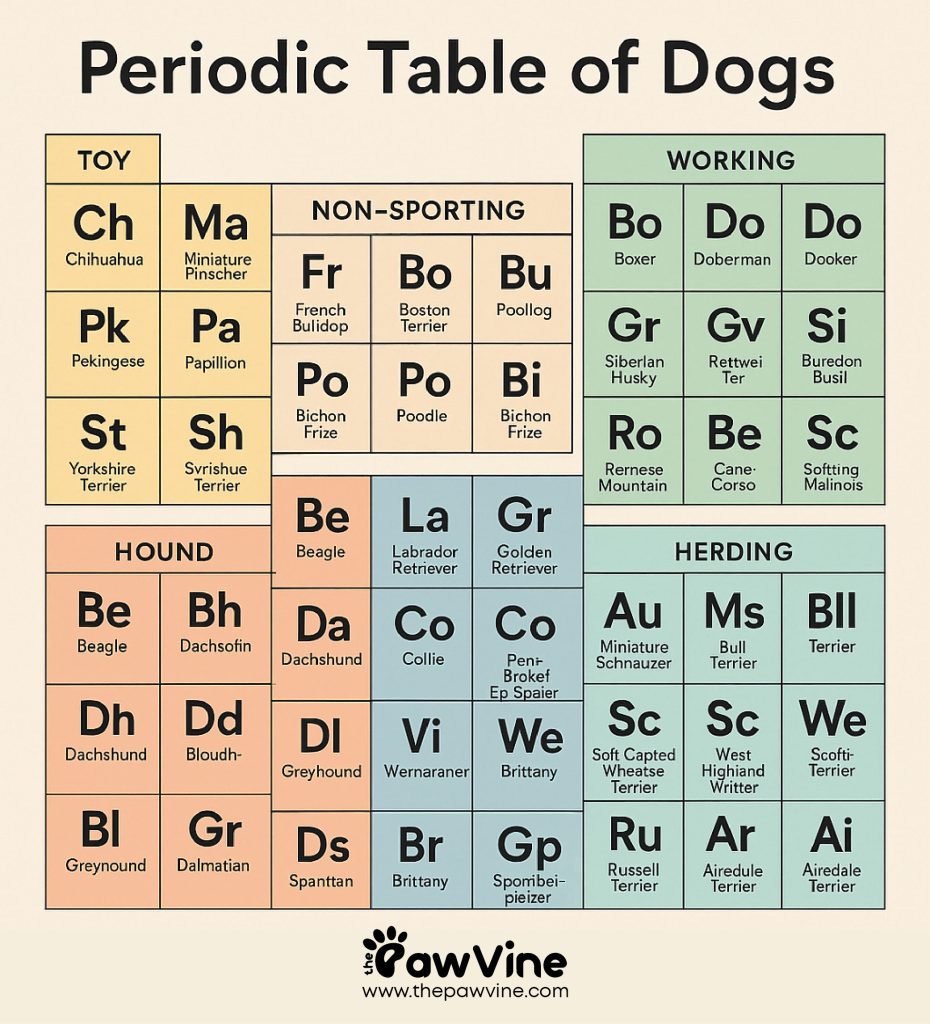Ever sat around and thought, “What if dog breeds had their own periodic table?” No? Well, once you do, it’s kinda hard to stop thinking about it.
Imagine walking into a vet clinic or a dog show and seeing a colorful chart where Labradors are next to Golden Retrievers, and Chihuahuas are grouped like the noble gases of the dog world.

It’s not science class. It’s just a fun way to sort out the chaos of all the dog breeds out there.
Dogs come in more shapes and sizes than sweets in a British corner shop. Some are built like tanks, others like teacups.
They’ve got their quirks, their moods, and their grooming demands. So yeah, if the elements of chemistry get their own neat table, why not our four-legged pals?
The “Groups” and “Periods” of the Canine World
Let’s get nerdy but not too nerdy. In the dog version of the periodic table, “groups” are basically categories of dog breeds that share a common vibe.
Like the working group, full of dogs who were bred to, well, work. Herd, pull, guard, fetch your socks, that sort of thing.
Then we’ve got “periods,” think of those as layers that tell you something about their size, energy, or temperament.
Maybe the top row is the little lap warmers. Move down and you hit the medium fluffballs. Bottom row? The big lads who knock over your pint with a tail wag.
A Few Breeds as “Elements”
Let’s play around with some examples from this imaginary table.
Lb — Labrador Retriever
Classic. Reliable. Found in family homes like salt in a kitchen. High energy, loves to swim, and will happily eat anything that hits the floor.
Ch — Chihuahua
Small but mighty. Like a jalapeño in dog form. Loves a warm lap, but don’t be fooled, they’ll square up to a Rottweiler without blinking.
Bc — Border Collie
The genius of the bunch. Always thinking, always moving, probably judging you for sleeping in. Needs jobs. And we mean actual jobs. Herding sheep, solving puzzles, doing your taxes.
Sb — Shih Tzu
Fluffy, regal, and could not care less about your workout goals. Likes pillows, snuggles, and a touch of drama.
Dp — Dalmatian
A total looker. Spotted like a 101-piece jigsaw, full of beans, and always ready to zoom. Gorgeous but not exactly low-maintenance.
Now imagine each dog breed has a little “box” with stats. Size, coat type, origin, temperament, grooming needs. All the stuff you’d want in one quick peek before you get suckered in by those puppy dog eyes.
Group Highlights on the Table
Toy Group — These are the purse-sized pups with giant personalities. Think Pomeranians, Yorkies, Malteses. They might be small but they’ve got opinions.
Herding Group — Brainy, fast, and often bossy. If a Border Collie gives your toddler side-eye, don’t be surprised. They see everyone as sheep.
Working Group — Muscle and manners, when trained right. You’ve got your Dobermans, your Boxers, your Saint Bernards. Gentle giants and solid protectors.
Hound Group — Sniffers and singers. Bassets, Beagles, Greyhounds. They either follow their nose or nap like pros.
Terrier Group — Scrappy, bold, and full of cheek. These guys were bred to dig and chase. A Terrier will go after a squirrel with the fury of a thousand suns.
Non-Sporting Group — Basically the “miscellaneous” drawer. Bulldogs, Dalmatians, Chow Chows. All lovable oddballs.
Sporting Group — Labradors, Goldens, Spaniels. If it involves water, a ball, or your approval, they’re all in.
Energy Level and Grooming Needs
Here’s where the “periods” are handy. You could line them up from chill to turbocharged. Bulldogs and Basset Hounds at one end, bouncing Vizslas and Aussies at the other.
Same with grooming. Some dogs (hello, Poodle) need trims more often than you get your own hair cut. Others are wash-and-go. It’d be nice if that was on the chart too, wouldn’t it?
Not everyone wants a dog that needs a salon appointment every three weeks.
Why It’s Not Just for Fun
Sure, this whole idea is a bit silly on the surface. But it’s also a nifty way to understand breeds. Especially if you’re studying veterinary science, working in animal shelters, or just the go-to dog nerd in your friend group.
Kids would love it, too. Imagine learning breeds in school science class through dogs instead of chemical bonds. Bet more of us would’ve paid attention.
Real Life Inspiration
A teacher in Leeds once printed her own doggy periodic table for her classroom. She used it to teach responsibility and pet care.
The kids got to “adopt” a dog element and learn what made that breed tick. One student picked a Siberian Husky and wrote a paper about how much exercise it needed, then convinced her dad to take longer walks with their actual dog.
See? Even a made-up table can spark real learning.
Wrapping It All Up Like a Dog Burrito
The periodic table of dogs isn’t about replacing good ol’ breed research. It’s just a playful way to look at our furry mates and spot patterns in their traits.
Whether you’re picking your first pup, teaching your kid, or just bored at work making lists, it’s a fun way to make sense of the wonderfully weird world of dogs.
So if dogs were elements on a table, which one would be your favorite?